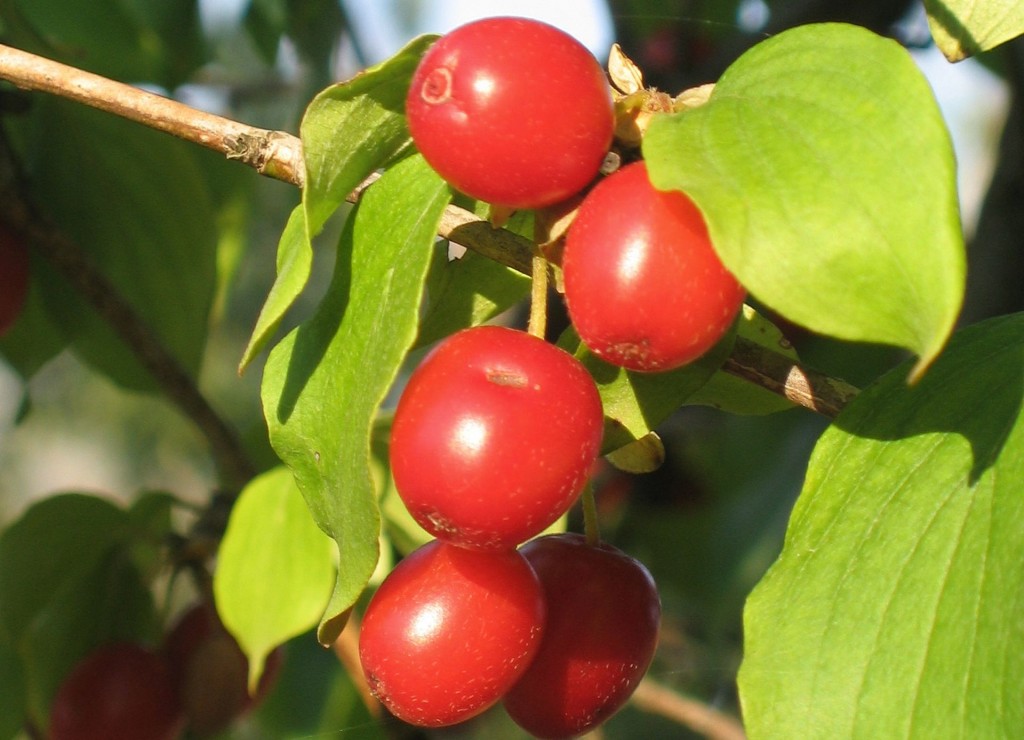 Have you ever seen or tasted cornelian cherries? In Montenegro they are called “drenjine”. Many foreigners probably do not know these wild berries that usually ripen in September, as they are consumed in Eastern Europe and Iran only. In Western Europe the tree is also grown as an ornamental plant for its late winter flowers, which appear well before the leaves (photo 1). For me it is a real pleasure to see the tiny yellow flowers of the wild Cornus trees in Montenegro, as they are the first sign that the winter is over, even when the mountains are still covered with snow (photo 2).
Have you ever seen or tasted cornelian cherries? In Montenegro they are called “drenjine”. Many foreigners probably do not know these wild berries that usually ripen in September, as they are consumed in Eastern Europe and Iran only. In Western Europe the tree is also grown as an ornamental plant for its late winter flowers, which appear well before the leaves (photo 1). For me it is a real pleasure to see the tiny yellow flowers of the wild Cornus trees in Montenegro, as they are the first sign that the winter is over, even when the mountains are still covered with snow (photo 2).
Cornelian cherries (also called cornels) are not really cherries. They look like deep red olives (photo 3). In ancient Greek literature, they were primarily considered food for pigs, but the Armenians, Greeks, Romans and Persians must have liked them in spite of this, because the cherries are often mentioned as edible fruits in their manuscripts.
 The Cornus tree was also used for other purposes. Its berries have a long history of use in traditional Chinese medicine, and its wood was used from the 7th century BC onward by Greek craftsmen to construct spears and bows. Red dye for clothes was produced from its bark and tannin from its leaves.
The Cornus tree was also used for other purposes. Its berries have a long history of use in traditional Chinese medicine, and its wood was used from the 7th century BC onward by Greek craftsmen to construct spears and bows. Red dye for clothes was produced from its bark and tannin from its leaves.
But also today, cornelian cherries are used in several ways. In Armenia, the fruit is used for distilling vodka and in Albania it serves for making raki. In Turkey and Iran it is eaten with salt as a snack in summer, and traditionally drunk in a cold drink called kizicik serbeti. As the berries are very high in vitamin C, they are also used to fight colds and flues.
Cornels are highly appreciated in the villages of central Montenegro. That is why I was very glad to get a bucket full of “drenjine” from our friend Mladen. Of course, I did not know how to prepare them, but his instructions for making delicious syrup were simple enough. And the result was excellent!
 That is why I want to share this experience with you and give you his recipe:
That is why I want to share this experience with you and give you his recipe:
Ingredients: 5 kg Cornelian cherries, 4 kg sugar, 4 Limuntus
Wash and drain the berries (photo 4); Add enough water to cover the berries; Boil for about 40 minutes; Strain through a small-mesh strainer or a cheesecloth, mashing the cooked berries; Discard the solids and wait until the juice has cooled to room temperature; Add the sugar and stir to dissolve it; Boil the syrup 30-40 minutes at medium heat; Pour into sterile jars or plastic bottles (you can store the syrup in the refrigerator for up to one week). For use: just add water or sparkling mineral water to the syrup to suit your taste.
Maybe it’s difficult to get the berries, but sometimes you can find them on the market, in September. Give it a try: it is a really refreshing and, above all, healthy drink! (photo 5)


[…] about all the treasures of autumn: pomegranates, olives and carob, domestic juice and marmalade of Cornelian cherries, herbal teas, smoked meat, home-made olive oil… A feast for the […]